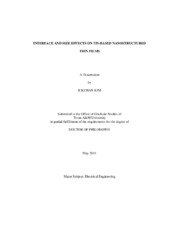| dc.description.abstract | Titanium nitride coatings have been widely applied and studied as high temperature diffusion barrier for silicon devices in microelectronics, wear resistant coatings in turbine blade materials, and materials for future high temperature nuclear reactors. In order to enhance the material property, superlattices is one of artificially engineered protective coatings, such as AlN/TiN and TaN/TiN multilayered films. Epitaxial cubic multilayer films, TaN/TiN and AlN/TiN nanolayers were grown on Si(001) by Pulsed Laser Deposition (PLD) with various nanolayer thicknesses and number of interfaces. Microstructural studies include X-ray diffraction (XRD), transmission electron microscopy (TEM), and high resolution TEM with ion-irradiation experiments. Electrical, mechanical and thermal property studies were conducted for the interface and size effects on the nanolayers by using nanoindentation and Transient Thermo-Reflectance (TTR) methods. The microstructural and hardness study on TaN/TiN films with ion irradiation (12 keV and 50 keV He ) suggest no obvious microstructural or mechanical behavior change due to ion irradiation. In addition, titanium nitride that serves as effective diffusion barrier to prevent the inter-diffusion between the nuclear fuel and the cladding material was studied in order to enhance the lifetime of the fuels and the reliability of the fuel claddings. The TiN has good adhesion with the stainless steel and higher hardness than that of bulk TiN on the stainless steel. Thermal conductivity test demonstrates that thin TiN film has compatible thermal conductivity as the MA957 and HT-9 bars. The size effect on electrical resistivity is dominant in both of the epitaxial cubic and the polycrystalline TiN thin films in the thickness ranged from ~60 nm down to ~35nm. In the TaN/TiN multilayer, the grain scattering effect on resistivity is dominant rather than interface influence on the resistivity with comparing epitaxial cubic phase and polycrystalline phase. The microstructure and hardness studies of the AlN/TiN multilayer films with He implantation present that the suppression of amorphization in AlN layers and the reduction of radiation-induced softening were achieved in all nanolayer films. Radiation tolerance was found to be size dependent and the layer thickness leading to the highest radiation tolerance was around 10 nm. In addition, the embedded epitaxial cubic AlN with cladding TiN nanolayers showed higher effective thermal conductivity than that of AlN single layer as well as the embedded polycrystalline AlN in the thickness ranged from 10 nm down to 2 nm. It confirms a suppressed size effect, which reduces the amount of decrease in through-plane thermal conductivity. | en |


